The document discusses the Bring Your Own Device (BYOD) movement in schools, highlighting its potential to enhance personalized and student-centered learning by allowing students to use their personal devices in the classroom. It addresses the advantages of BYOD, such as increased engagement and collaboration, as well as concerns about equity, potential distractions, and cybersecurity issues that need to be managed for successful implementation. Ultimately, it advocates for careful preparation and training to ensure that all students benefit from BYOD initiatives while reducing the digital divide.
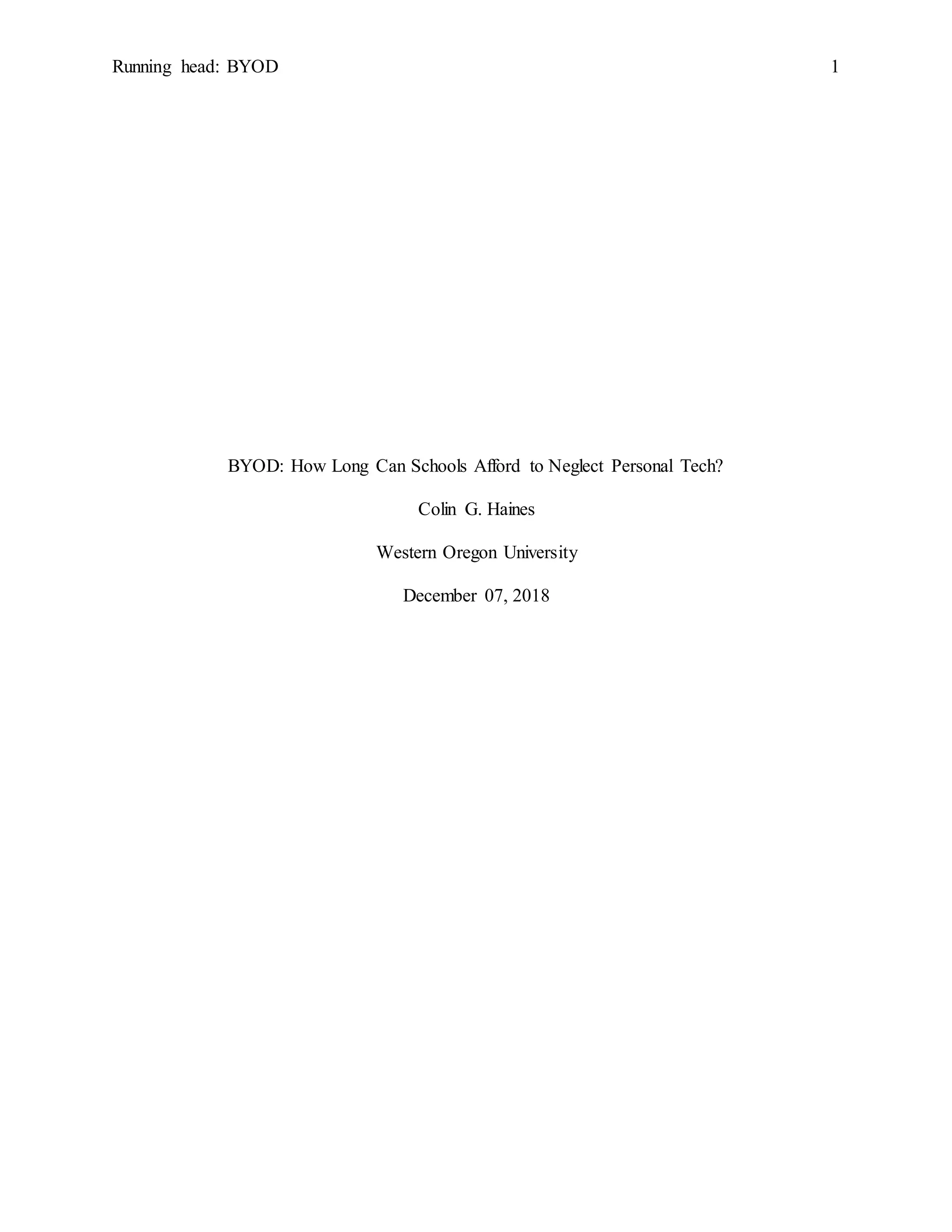
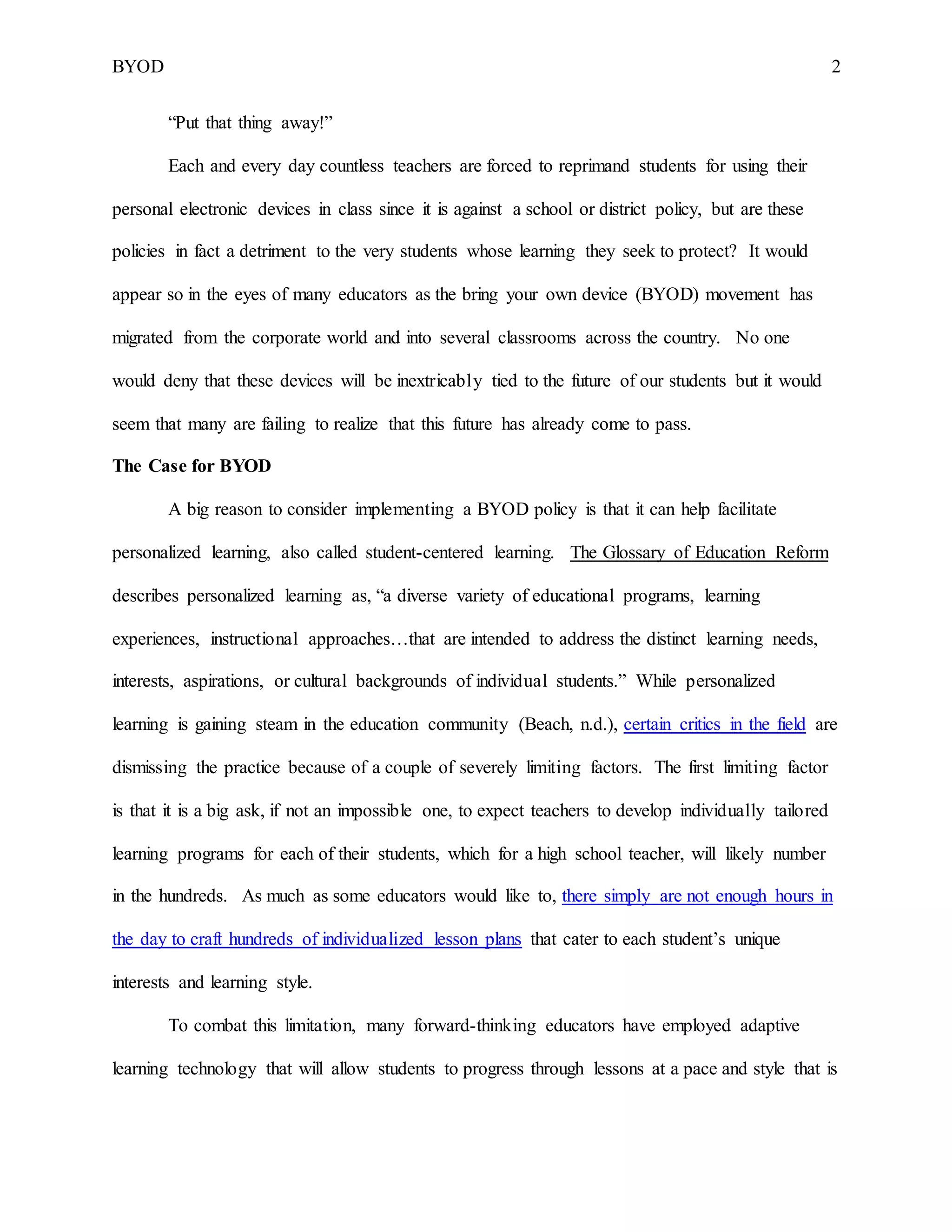
![BYOD 3
appropriate to each individual student. The issue with this system, however, is that in order to
run adaptive learning programs, a 1:1 student to device ratio is required, which would surely be
fiscally unfeasible for most schools. On teacher made the complaint, “I really like [personalized
learning], but I can’t personalize my students’ learning because I don’t have enough devices for
all of my students,” which is a complaint echoed by several educators. A BYOD policy has the
potential to relieve the issues surrounding lack of school devices since students’ own devices will
alleviate the school’s burden of supplying devices to every student. Considering that in 2015, 73
percent of teens owned or had access to a smartphone, is certainly a viable option (Rodgers,
2018). Robyn Howton (2017), for example, employs a philosophy of using the technology you
have, by allowing students to use their cell phones to access Schoology, their online learning
management system (LMS), and Wen 2.0 tools such as Google Docs.
There are already examples of teachers successfully implementing a BYOD program in
their classrooms. Fourth grade teacher Rachel Card is one such example. Card (2014) began
allowing her students to bring their own devices to class in order to access online resources, Web
2.0 tools, and her classroom website. She found that her students genuinely enjoyed activities
like blogging, digital storytelling, and being able look up information on their own as opposed to
having it handed to them. At the end of eight weeks of implementation, Card surveyed her
students about their experiences and found that students felt BYOD enhanced their classroom
experience and based on her own observations, found that BYOD fostered a greater degree of
student engagement.
Advantages of BYOD
A big advantage of having 1:1 student technology is that it creates a seamless flow for the
sharing of electronic documents, thoughts, and information (Beach, n.d.; Bruder, 2017; Rodgers,](https://image.slidesharecdn.com/hainesonlinepaper-190310235401/75/BYOD-How-Long-Can-Schools-Afford-to-Neglect-Personal-Tech-3-2048.jpg)
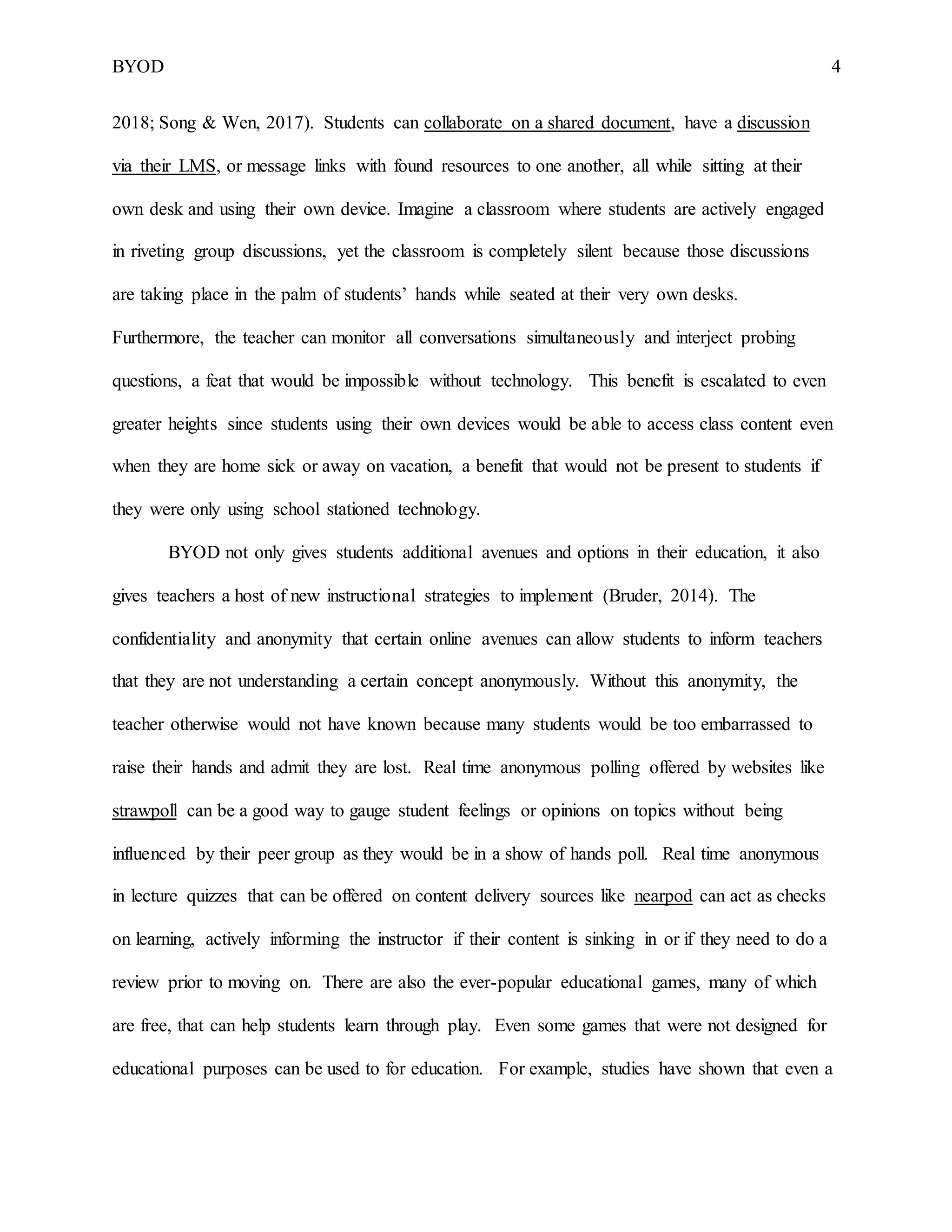

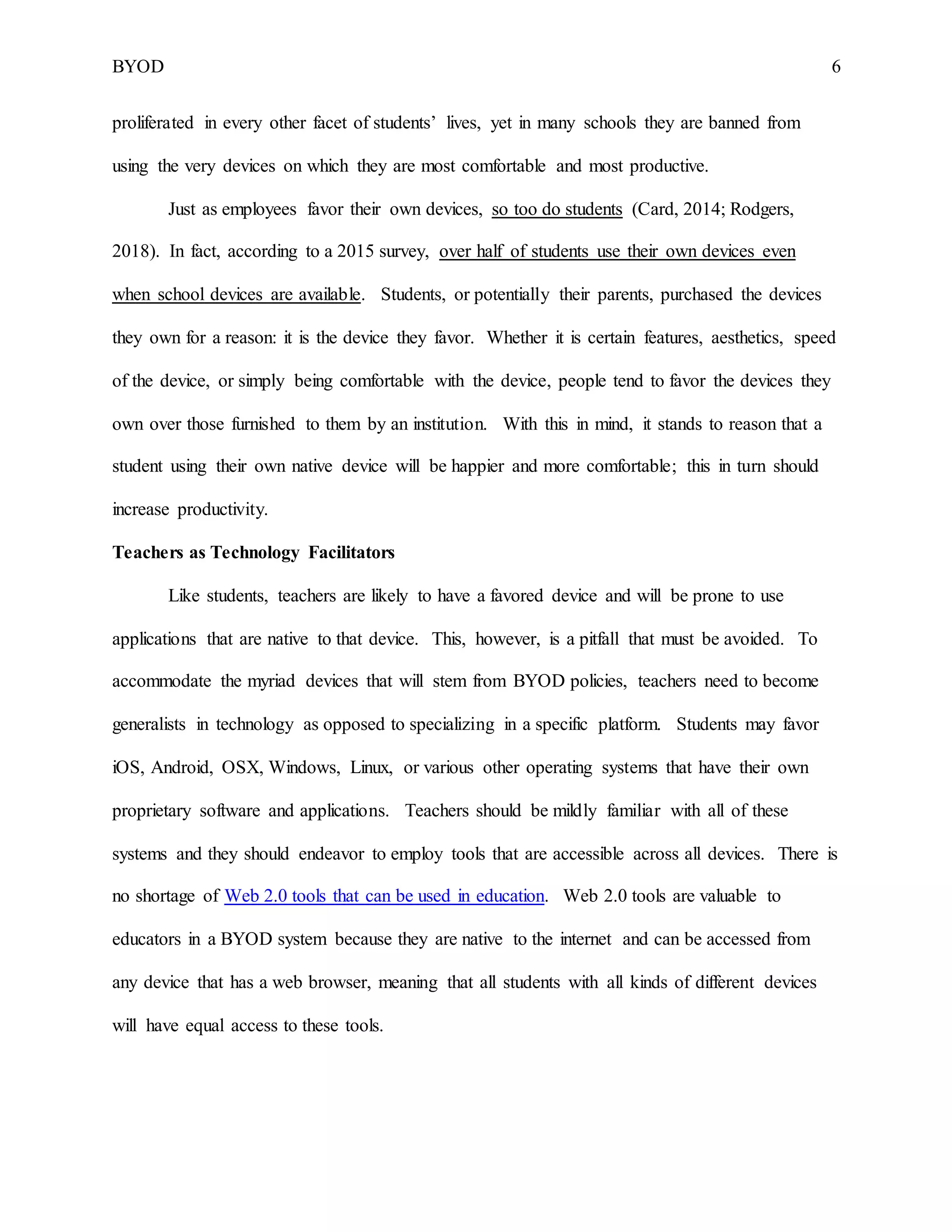
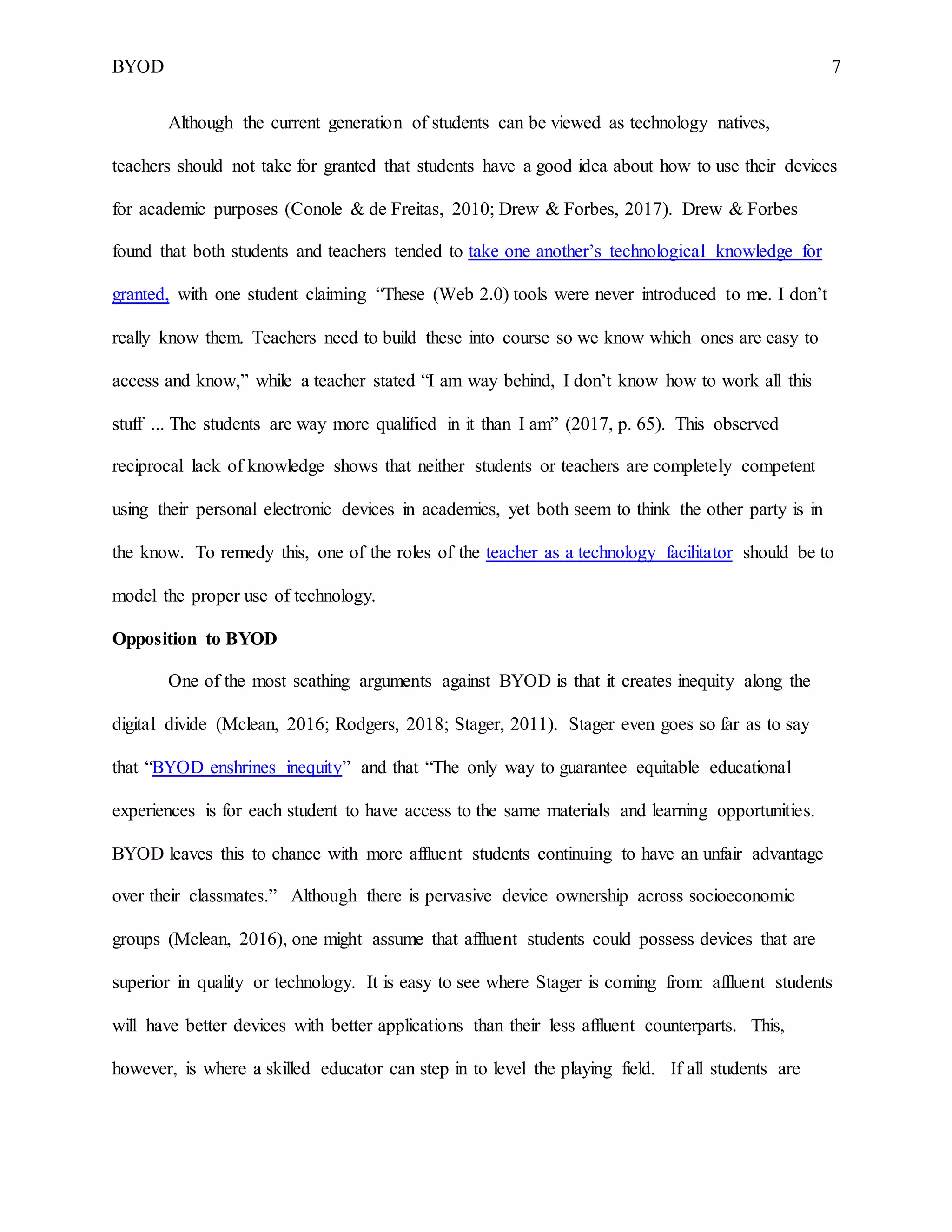

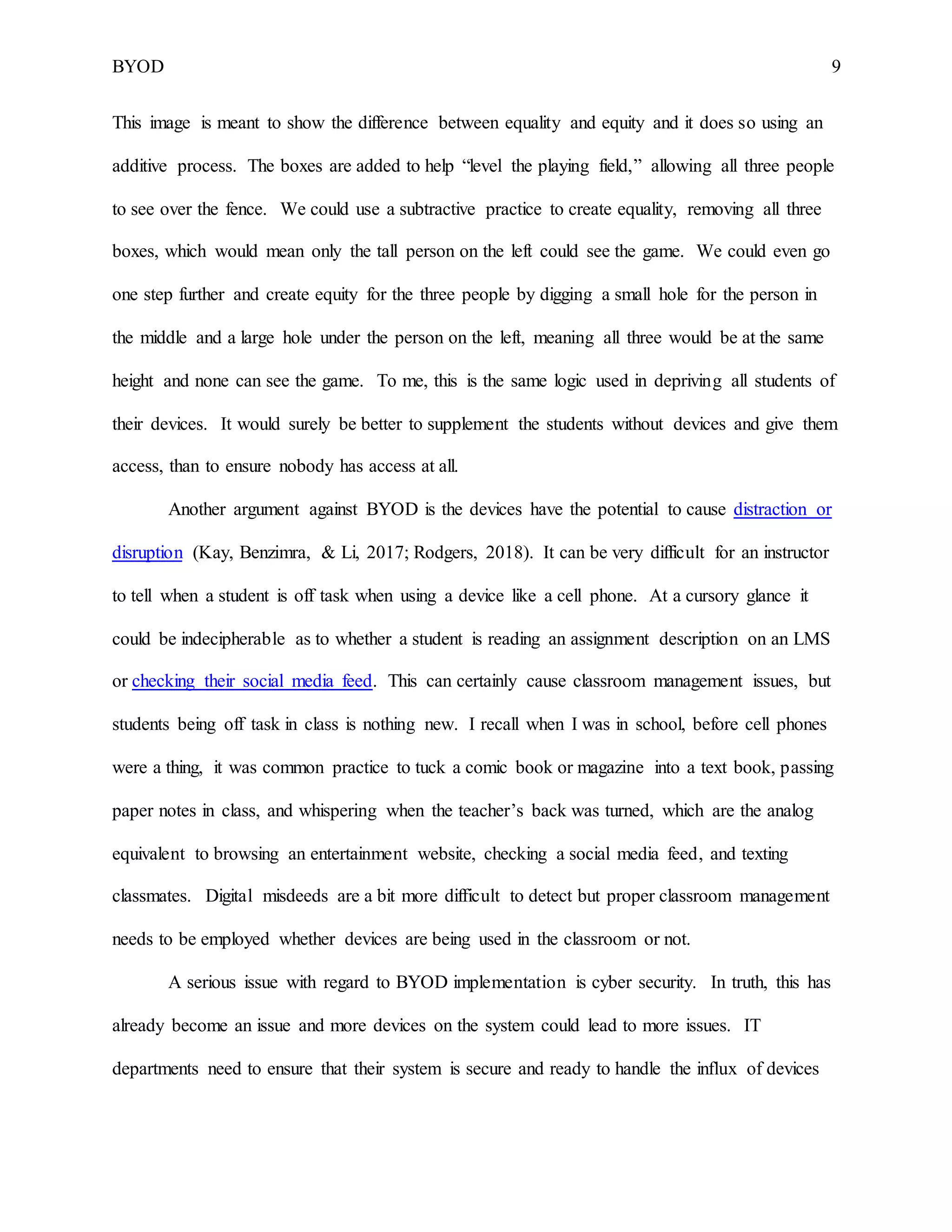


![BYOD 12
References
Beach, M. (n.d.). How Schools are Implementing 'Bring Your Own Device'. Retrieved
November 12, 2018, from http://teachmag.com/archives/7706
Bruder, P. (2014). Gadgets Go to School: The Benefits and Risks of BYOD (Bring Your Own
Device). Education Digest, 80(3), 15. Retrieved from http://ezproxy.wou.edu/login
?url=http://search.ebscohost.com/login.aspx?direct=true&db=f5h&AN=99173566&login
.asp&site=ehost-live
Bradley, T. (2011, December 20). Pros and Cons of Bringing Your Own Device to Work.
Retrieved November 07, 2018, from https://www.pcworld.com/article/246760/
pros_and_cons_of_byod_bring_your_own_device_.html
Card, R. (2014). Bring Your own Device (BYOD) Action Research. Retrieved November 02,
2018, from http://byodactionresearch.weebly.com/
Conole, G., & de Freitas, S. (2010). In R. Sharpe, H. Beetham, & S. de Freitas (Eds.), Rethinking
learning for a digital age: How learners are shaping their own experiences. Florence,
KY: Routledge. Retrieved from http://www.ebrary.com
Drew, L., & Forbes, D. (2017). Devices, distractions and digital literacy: ‘Bring your own
device’ to polytech. Teachers and Curriculum,17(2). doi:10.15663/tandc.v17i2.157
Fryer, W. & Kim, J. (Host). (2018, October 10). EdTech Situation Room Episode 110 [Audio
Podcast]. Retrieved from http://edtechsr.com/podlove/file/886/s/download/c/select-
show/edtechsr110-10oct2018.mp3
Howton, R. (2017, August 18). Turn your classroom into a personalized learning environment.
Retrieved November 17, 2018, from https://www.iste.org/explore/articleDetail?
articleid=416](https://image.slidesharecdn.com/hainesonlinepaper-190310235401/75/BYOD-How-Long-Can-Schools-Afford-to-Neglect-Personal-Tech-12-2048.jpg)
![BYOD 13
Kay, R., Benzimra, D., & Li, J. (2017). Exploring Factors That Influence Technology-Based
Distractions in Bring Your Own Device Classrooms. Journal of Educational Computing
Research, 55(7), 974–995. https://doi.org/10.1177/0735633117690004
Mclean, K. J. (2016). The Implementation of Bring Your Own Device (BYOD) in Primary
[Elementary] Schools. Frontiers in Psychology,7. doi:10.3389/fpsyg.2016.01739
Mathiason, G. (2012, May 15). United States: The "Bring Your Own Device" To Work
Movement. Retrieved December 1, 2018, from https://www.mondaq.com/unitedstates/x/
177472/Employee Rights/The Bring Your Own Device To Work Movement
Ransey, K. (2018, July 18). What Personalized Learning Is Not - EdSurge News. Retrieved
December 1, 2018, from https://www.edsurge.com/news/2017-09-01-what-personalized-
learning-is-not
Rodgers, D. (2018, March 16). BYOD in Schools: A Beginner's Guide. Retrieved November 07,
2018, from https://www.schoology.com/blog/byod-in-schools-a-beginners-guide
Rodrigues, M. J. & Carvalho, P. S. (2013). Teaching physics with Angry Birds : exploring the
kinematics and dynamics of the game. Physics Education. 48. 10.1088/0031-
9120/48/4/431.
Song, Y., & Wen, Y. (2018). Integrating Various Apps on BYOD (Bring Your Own Device) into
Seamless Inquiry-Based Learning to Enhance Primary Students’ Science
Learning. Journal of Science Education and Technology, 27(2), 165–176. Retrieved from
http://ezproxy.wou.edu/login?url=http://search.ebscohost.com/login.aspx?direct=true&db
=eric&AN=EJ1172006&login.asp&site=ehost-live
Stager, G. (2011). BYOD-worst idea of the 21st century. Retrieved from
http://www.stager.tv/blog/?p=2397](https://image.slidesharecdn.com/hainesonlinepaper-190310235401/75/BYOD-How-Long-Can-Schools-Afford-to-Neglect-Personal-Tech-13-2048.jpg)